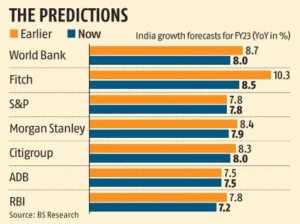In news–World Bank has released the “South Asia Economic Focus” report recently.
Key highlights of the report-
- The report describes recent economic developments, analyzes the economic impact on South Asia of the war in Ukraine, presents growth forecasts, provides risk scenarios, and concludes that reshaping economies goes hand in hand with reshaping norms.
- As per the report, the South Asia region is projected to grow by 6.6 percent in 2022 and 6.3 percent in 2023.
- The 2022 forecast has been revised downward by 1.0 percentage point compared to the January projection, due to the impacts of the war in Ukraine.
- The recovery in the region, already uneven and fragile, will be weakened by the impact of war in Ukraine, contributing to inflation and deteriorating current account balances, amid increasing indebtedness.
- All countries in the region will face challenges ahead, grappling with rising commodity prices, supply disruptions, and vulnerabilities in financial sectors.
- Inflation is expected to rise in all countries in 2022 before subsiding in 2023.
- For the region as a whole, headline inflation is expected to be 7.0 percent in 2022 (up from 6.7 percent in 2021).
- Many South Asian countries rank among the lowest in the world in terms of female labor force participation, as well as other forms of gender disparities, such as freedom of movement, social interactions, asset ownership, and son preference.
On India’s Economic growth predictions-
- When it comes to India’s economy, South Asia’s largest, is expected to grow by 8 percent in FY 22/23(reduced to 8% from 8.7%).
- The recovery in household consumption will be constrained by the incomplete recovery in the labour market and inflationary pressures.
- Recently, the RBI lowered the GDP growth forecast to 7.2% from 7.8% and also raised the inflation forecast to 5.7% from 4.5%.

- The report said increased government capital spending (especially in infrastructure and logistics), reduced vulnerabilities in the financial sector, government initiatives including the production-linked incentive scheme and improvement of the investment climate will support investment.
- The current account deficit will widen substantially as the merchandise trade deficit increases on the back of rising commodity prices.
- Capital flows, especially foreign direct investment inflows, are expected to remain steady- given the reforms implemented to improve the business environment.
















